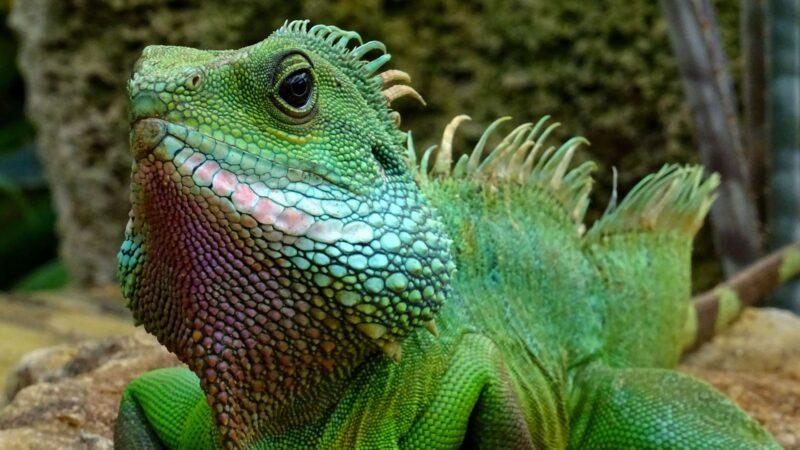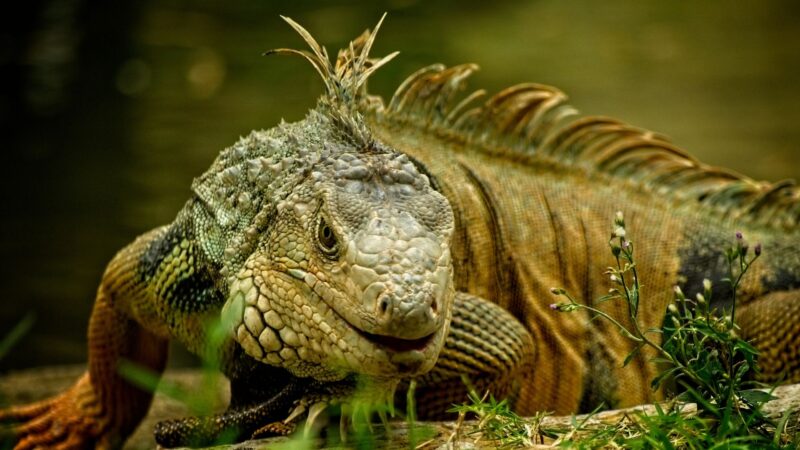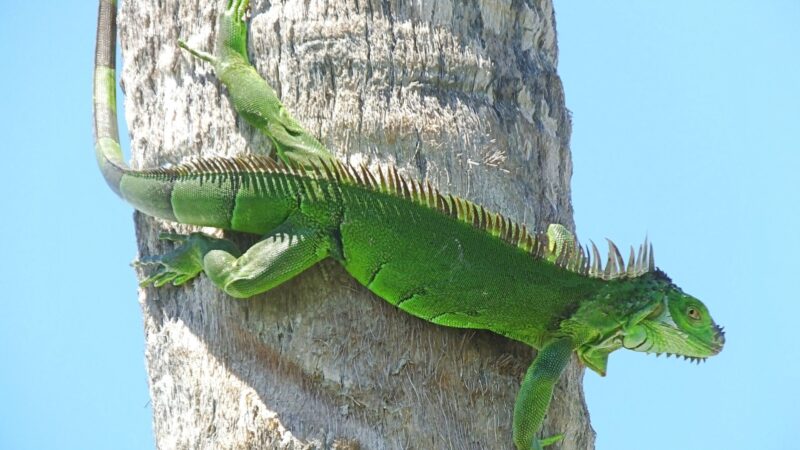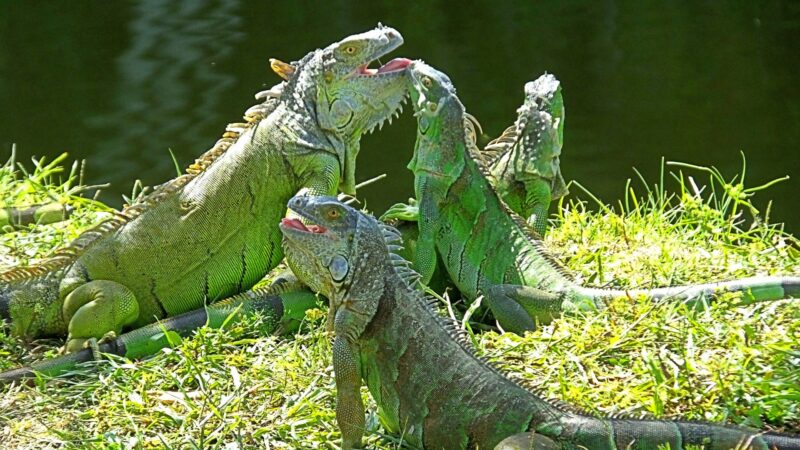It’s simple, really: green iguanas are a menace to society. They continue to raid residences for food and burrow underground in properties. Dealing with them is tricky, but should be done right away!
So, how to get rid of green iguanas? Spray them with water, catch them using humane methods, hang up wind chimes or reflective objects, or contact local professional pest control services to safely remove and relocate them.
This article provides all relevant information on eliminating these nuisances and preventing them from coming back. Read further for more!
What Are Green Iguanas?

Considered native tropical forest lizards, green iguanas (Iguana iguana) are large arboreal reptiles that occur across Central and South America. They have been introduced outside of their native range as a result of commercial pet trade and pets that have escaped or have been released.
Other than green, they may also be brown. They can change their color depending on a lot of factors. This includes their mood, health, or environmental temperature.
Green iguanas are also characterized by their dewlap, spines from its neck down to its back, and long, tapered tail.
What Do Green Iguanas Like?
Green iguanas are known for basking under the sun as this helps in harnessing warmth into their bodies. They usually do it on flat, open areas but they can be spotted basking on coastal debris.
What Do Green Iguanas Eat?
They usually prefer ripe fruits or leafy plants. But they occasionally consume a small amount of invertebrates and carrion, technically categorizing them as omnivores.
Green iguanas need a lot of protein in their first 2 to 3 years of growth, which is why they typically eat insects and spiders at this time. Once they reach maturity, they switch to a more calcium-rich, leafy diet.
Related: What Do Backyard Lizards Eat? | Information and Facts
Where Do Green Iguanas Live?
Green iguanas are tree-dwellers, preferring to reside in tree canopies located at high elevations. They are also well-adapted to open areas as long as there is a water source nearby.
Outside their native range, they live in trees, shrubbery, or on the ground in urban and suburban areas.
How Long Do Green Iguanas Live?
They have a lifespan of up to 10 years in the wild and up to 20 years in human care.
How Big Will Green Iguanas Get?

Adult green iguanas can reach lengths of up to 2 meters. This translates to a range of 4 to 8 kilograms in weight.
What Is the Behavior of Green Iguanas?
Green iguanas are solitary and mostly active during the day. They are particularly territorial during the breeding season against other individuals. They spend most of their time lying down in cool areas.
Their means of communication involves visual signals, such as extending their dewlaps or bobbing their heads.
What Attracts Iguanas to My Property?
That’s easy: food. Iguanas are highly attracted to landscape and properties with plenty of fruits (except citrus), trees with flowers or foliage, and nearly any vegetable. Moreover, they may also find suitable habitats in these areas.
Green Iguanas Damages in Property

Green iguanas can cause significant damage to properties. They’re known for the following concerns:
- Damage to both commercial and residential landscape vegetation
- Damage to infrastructure as they dig burrows that allow foundations and sidewalks to erode and collapse. In fact, West Palm Beach in Florida had spent nearly $2 million to repair a dam that iguanas burrowed into.
- Leaves droppings on porches and swimming pools which may become a slipping hazard especially for children
- Congregates and basks in open areas, making them a nuisance
- Aside from property damage, they are also culprits of biodiversity loss as they reduce insect and plant populations
Are Green Iguanas Dangerous?
In some cases where they have to defend themselves, they may become dangerous. Normally, they tend to avoid people. But they resort to scratching, biting, or swiping their tail which may lead to injuries.
Do Green Iguanas Carry Diseases?
Yes, they harbor salmonella bacteria in their intestinal tracts which is shed from time to time through the lizard’s fecal droppings. Once humans touch these, whether accidental or intentional, complications may arise such as gastroenteritis and salmonellosis.
Are Green Iguanas Protected?
It depends on the state. In some areas, it may be illegal to kill invasive green iguanas but poison or shooting is prohibited while in other regions, they may be protected by state laws and regulations.
Can I Kill the Green Iguanas on My Property?
Again, it depends on which side of the country you’re on. Check state laws and regulations first and foremost. However, we still highly recommend getting rid of green iguanas using humane methods.
Related: How To Get Rid of Lizards in Your House and Around the Yard Without Killing Them
How to Get Rid of Green Iguanas?
Now that you’re aware of the damage that green iguanas cause, you can get rid of them by adopting a multifaceted approach:
- Hang wind chimes: Other objects that create intermittent noises also work against deterring green iguanas.
- Hang reflective material: This includes old CDs, reflective tape, metallic strips, and other items.
- Spray with water: Directly spray water on a green iguana using a hose. This immediately gets them off of your property.
- Catch the iguana: If you have the time, patience, and bravery to do so, you can catch iguanas by hand, establishing traps, or by using noose poles or nets.
- Contact professional wildlife services: If you are unable to achieve success with the methods mentioned above, it’s time to contact professionals to safely remove and relocate green iguanas.
How to Prevent Green Iguanas in the Future?

Prevent future iguana invasions by considering the following strategies:
- Do not feed them: Not only are they attracted to food, they may also lose their natural fear of humans and become aggressive.
- Discourage burrowing: Fill holes around your property with soil or other appropriate material to make them less appealing as hiding spots.
- Encourage former pet owners to surrender their iguanas: Iguanas may have been introduced outside their native range as owners release them into the wild. Instead, they must be surrendered to local wildlife authorities.
- Remove attractive plants: As much as possible, reduce the abundance of potential food sources for the lizards to prevent them from coming back.
- Install sheet metal: Prevent iguanas from climbing up trees by creating a barrier made out of sheet metal around it.
- Install enclosures: Guard your plants using cages or screens that are held up by PVC frames.
- Grow plants that iguanas dislike: This includes oleander, milkweed, citrus fruits, and other thick-leaved plants. If you can, avoid planting squashes, melons, roses, hibiscus, roses, and green vegetables.
Related: 9 Best Lizard Repellents That Actually Work | A Detailed Guide
List of Sources
Borcyk, P. et al. (n.d.). Florida’s Introduced Reptiles: Green Iguana (Iguana iguana).
Carrington, A. C. (2011). Iguana iguana (Green Iguana).
Coles, W. (2002). Green Iguana: Iguana iguana.
Florida Fish and Wildlife Conservation Commission. (n.d.). Green Iguana: Iguana iguana.
Gildersleeve, S. (2021). Green Iguanas: The Changing Landscape.
Gingell, F. (n.d.). Iguana iguana: Common Green Iguana.
Lamar University. (n.d.). Green Iguana
- How to Get Rid of Copperheads | Practical Guide - August 27, 2023
- How to Get Rid of Corn Snakes | What Makes Them Aggressive? - August 27, 2023
- How to Get Rid of Alligators | Safety Measures and Removal Methods - July 16, 2023
